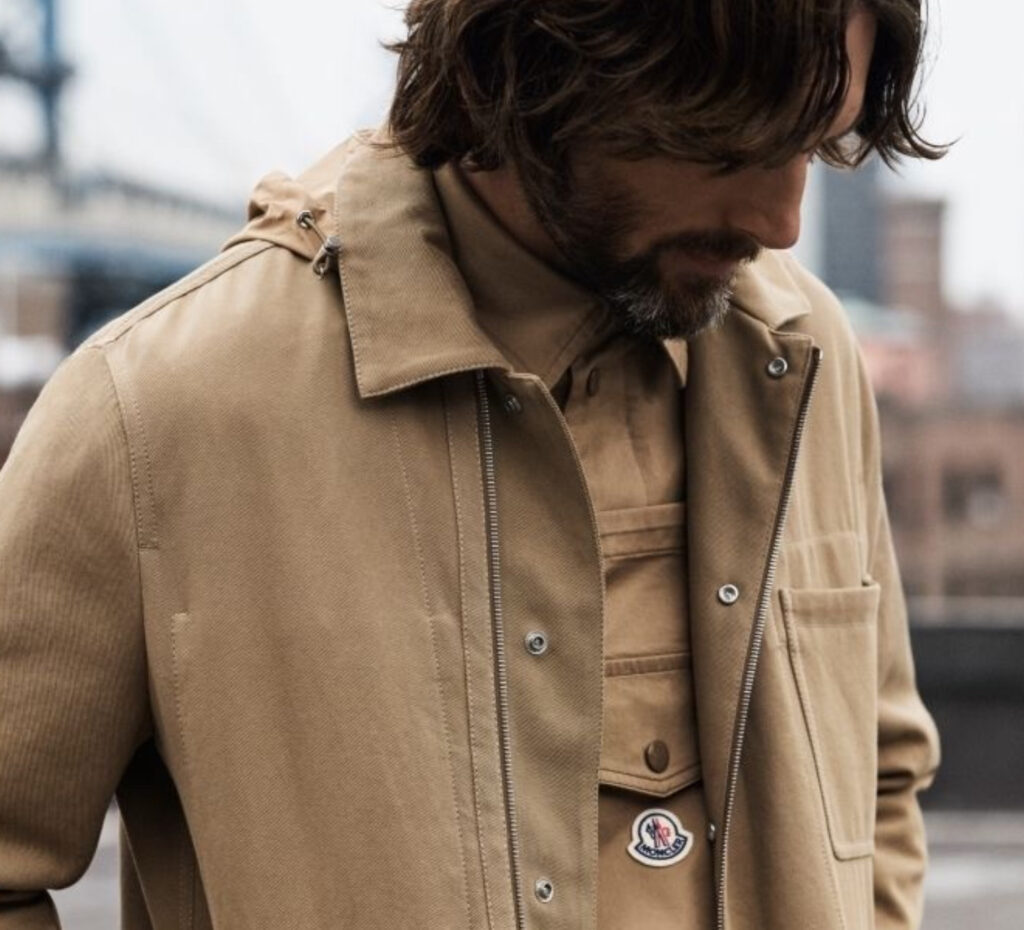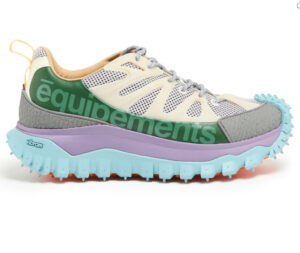In the post-haute landscape of 2025, where brand legacies must contend with streetwise pragmatism and climate-fluid lifestyles, Moncler continues its silent metamorphosis. What once defined the winter elite—down-filled alpine silhouettes, snowbound flair, and ski-chic outerwear—now reemerges in warmer months as something grittier, more elemental, and surprisingly urban. The Moncler Summer Collection reveals not just a seasonal pivot but a thoughtful refashioning of rugged workwear into metropolitan essentials.
Moncler, long lauded for its performance-meets-polish aesthetic, has embraced the hardwearing vernacular of utility gear and reimagined it with sharp tailoring, resilient materials, and adaptable design for the warm-weather city-dweller. This is not about survival in the wilderness, nor glamor in the lodge. This is about the modern wardrobe that balances work and wandering, sidewalk and skyline, with clothing that looks as at home in a Soho gallery as it does in a ferry terminal on the Adriatic coast.
Urban Durability, Alpine Origins
At its core, Moncler has always been about extremes—extreme environments, extreme precision, extreme brand control. Born in Monestier-de-Clermont in 1952 and propelled to global fame through its performance jackets and Olympic partnerships, Moncler built its image on technical prowess. But over the last decade, the brand has evolved beyond winterwear. The Genius program launched in 2018 dismantled seasonal boundaries and initiated capsule dialogues between Moncler and vanguard designers like Craig Green, Hiroshi Fujiwara, and Matthew Williams. The summer 2025 collection is a culmination of these conversations—less collaborative spectacle, more internalized maturity.
Moncler’s approach to summer wear this year reads as methodical, architectural. The silhouettes are structured but never stiff. A palette of mineral tones—graphite, limestone, bleached olive, sun-faded yellow—grounds the collection in earthy functionality. Think: field jackets reinterpreted as ventilated overshirts, cargo trousers with cinched hems and pleated utility pockets, drawstring parkas made from ripstop nylon so featherlight they ripple in sidewalk breezes. These are garments with lineage—referencing French work uniforms, mountaineering kits, and military standards—yet they’ve been recontextualized for people who ride electric bikes to co-working spaces and navigate cities designed as much by concrete as by cloud.
Construction as Philosophy
The tactile essence of the Moncler Summer Collection is arguably its most compelling feature. Whether through resin-coated canvas, garment-dyed cotton-linen blends, or breathable techno-fabrics with bonded seams, the pieces carry an industrial tactility that feels prepared for labor—even if that labor is metaphorical. This is clothing that suggests readiness.
The shirts are structured like chore coats. The shorts, designed with double-layer gussets, mimic carpenter designs but fall with a fashion-forward drape. Bucket hats and utility belts finish the look without veering into costume. Even the T-shirts avoid passivity—constructed with reinforced shoulder panels and contrast stitching to reinforce the ethos of resilience.
Of particular note are the convertible garments—jackets that transform into crossbody bags, trousers that zip off into shorts, gilets with modular inserts. This is the language of adaptation, a wardrobe fluent in transitions: work to drinks, downtown to out-of-office. Moncler doesn’t just make summer gear; it articulates the lifestyle of the urban nomad who demands both form and function, polish and protection.
Between Tradition and Subversion
This season’s ruggedness is not about nostalgia for blue-collar aesthetics; it’s about acknowledging the tools of the present. While workwear has been a fashion trope for decades—repurposed by everyone from Yohji Yamamoto to Carhartt WIP—Moncler doesn’t romanticize it. Instead, it engineers it. It reframes it within the codes of metropolitan style and lets luxury slip in quietly through finishing, fit, and fabric.
Take the double-pocket overshirt in storm grey cotton twill: its silhouette nods to utility, but the seams are laser-bonded and the buttons are mother-of-pearl dyed to match. The branding is subtle—embossed into rubber tabs, or ghosted in tonal embroidery along hem tapes. It’s workwear without the weight. The kind of craftsmanship that appeals not only to stylists or collectors, but to the pragmatists of contemporary dressing: people who want beauty and backbone in equal measure.
Moncler’s subtle genius here is in restraint. Where some luxury brands exploit the visibility of workwear—blaring logos across chore coats or turning hi-vis into fashion gimmicks—Moncler takes a quieter route. The garments are self-contained, complete. They don’t beg to be noticed, but they do reward attention. A concealed zip here. A heat-reactive print there. Garments that shift and breathe and patina with wear.
Footwear and Accessories: Form Anchored by Function
The summer collection also expands its vocabulary with footwear and accessories that echo its core themes of resilience and movement. The boots and low-top trail sneakers utilize Vibram soles, mesh-panels for breathability, and hybrid lacing systems that evoke hiking gear without feeling rustic. These aren’t boots for summiting peaks—they’re for navigating cobblestones, metro staircases, and heat-slicked airport terminals.
Accessories lean utilitarian but refined. Crossbody rigs in tech fabric replace traditional backpacks. Wide belts double as modular loops for clipped-on pouches. Sunglasses adopt wraparound silhouettes, with frames inspired by glacier goggles but reworked for street function. Moncler hasn’t abandoned its mountaineering DNA—it has simply retranslated it for a different kind of ascent.
The New City Uniform
In this way, Moncler’s summer offering creates what can only be described as a new city uniform—a modular kit designed for frictionless transitions between environments and expectations. These aren’t trend pieces. They aren’t resort fantasies. They’re tools disguised as tailoring, built with modern pressure in mind.
They appeal to the contemporary creative class: filmmakers, photographers, architects, tech visionaries—those whose work doesn’t demand hard labor but still carries conceptual weight. Moncler gives them a wardrobe that expresses this ethos. Durable enough to withstand a long-haul flight, refined enough to wear into a gallery opening, technical enough to weather a summer storm.
And in doing so, Moncler speaks fluently to a moment when resilience is no longer optional. In a climate of uncertainty—literal and cultural—what we wear becomes armor. But not the armor of aggression. Instead, it’s quiet strength. Precision in seams. Intent in material. Clothes that don’t ask to be admired, only used well.
From Mountain Ridge to City Grid
Moncler’s Summer Collection 2025 is not a reinvention—it’s a reconciliation. It brings the heritage of rugged wear into dialogue with the contemporary realities of city living. It transforms functionality into elegance and turns utility into a kind of poetry. Where once Moncler outfitted climbers for the summit, it now equips thinkers, creatives, and explorers for the city’s peaks and valleys.
By channeling the logic of workwear without mimicry and engineering garments for a truly modular lifestyle, Moncler continues to evolve the idea of what luxury looks like in motion. It doesn’t shimmer—it endures. It doesn’t shout—it withstands. It’s not a vacation wardrobe. It’s a new kind of uniform. And in a world where the journey is increasingly unpredictable, Moncler’s summer ruggedness feels like clarity, precision, and quiet power—worn lightly, but never taken lightly.
No comments yet.









